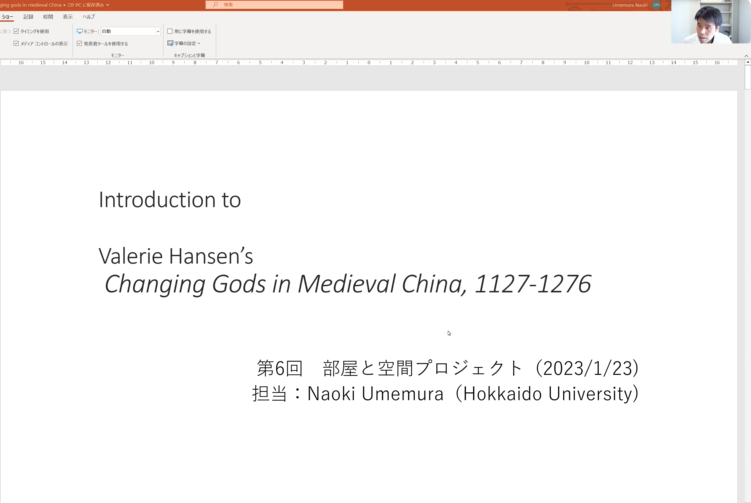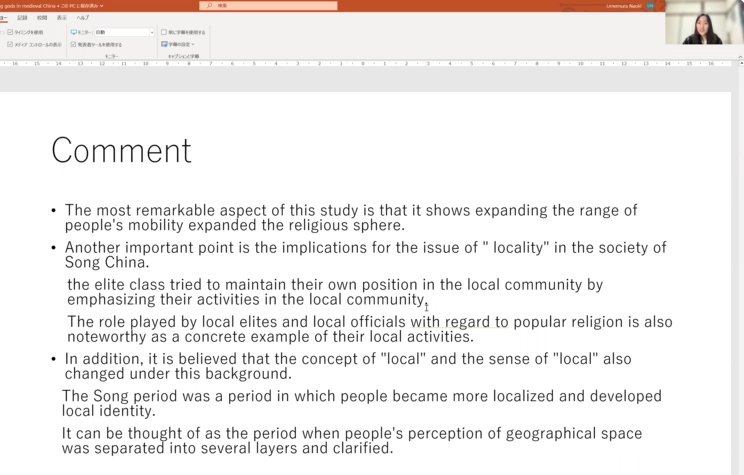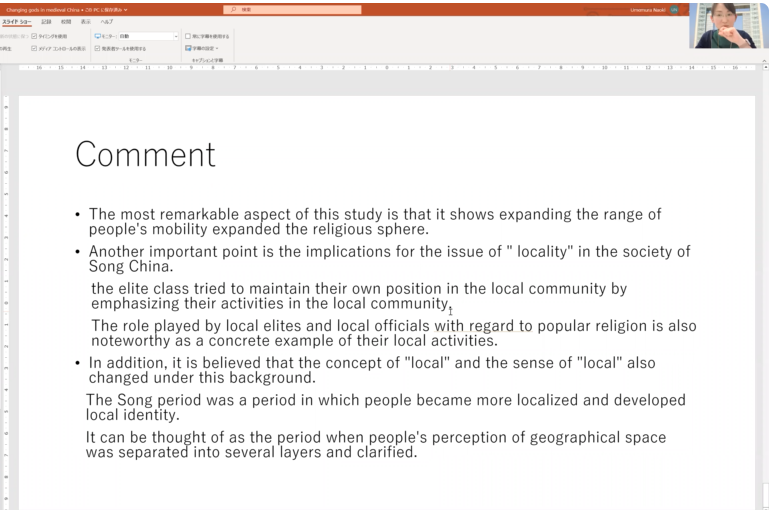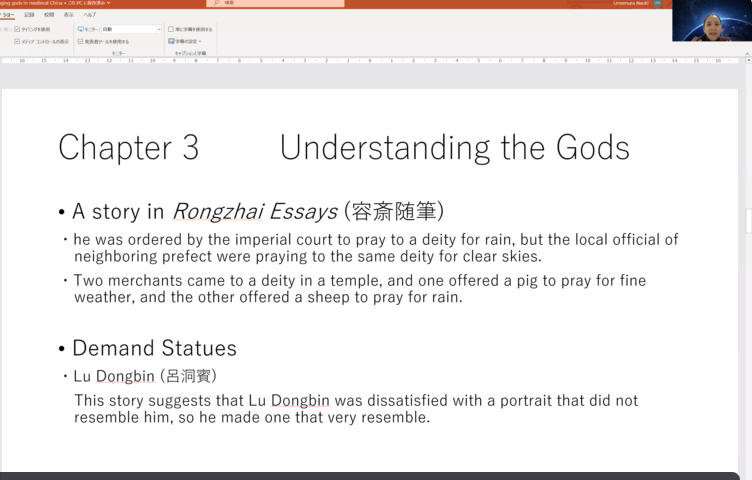The Room and Space Research Group held its sixth meeting at 1:00 pm on January 23, 2023. Naoki Umemura (Hokkaido University) gave a presentation on “Religious spaces and locality in medieval China; Valerie Hansen’s Changing Gods in Medieval China, 1127–1276.”

The aim of Hansen’s book is to analyze different aspects of popular religious change. Besides the established religions of Buddhism, Taoism, and Confucianism, there are popular religions in China. Popular religions are those that were practiced by illiterate people. This book focuses not on Confucianism, Buddhism, and Taoism, which are discussed by intellectuals, but on the beliefs of the illiterate, by analyzing their stories in detail in various documents. It discusses what kind of gods people came to believe in, what kind of gods were chosen, and how the gods themselves changed along with economic development in medieval China.
Dr. Umemura explained each chapter of this book. Chapter 1 (Introduction) describes the historical background. In times of epidemics, drought, torrential rain, or invasion by bandits or armies, lay people prayed to the deities for help, but which deities did they pray to and how did they choose? Chapter 2 (Lay Choices) describes the world of the deities as seen through their eyes, based on the descriptions in The Record of the Listener (夷堅志) by Hong Mai (洪邁, 1123–1202). Chapter 3 (Understanding the Gods) discusses various aspects of the deities found in popular religions. The deities of popular religions had interdependent relationships with people of their time and were benevolent, humorous, sometimes vengeful, and oftentimes capricious. Chapter 4 (The Granting of Titles) discusses an important process by which the deities of popular religions were recognized. The granting of titles to deities by the central government gradually became universal from the late eleventh century. When a local official applied to the central government for the granting of titles to a certain deity, the central government would then investigate whether the deity had manifested miracles. Chapter 5 (Popular Deities in Huzhou) and the following chapters are appreciated sections of the discussion that relate Song dynasty popular religions to geographical conditions and the formation of commercial areas. This chapter provides a detailed analysis of the deities of popular religions, focusing on one region, Huzhou. Huzhou was a commercial city that underwent a major transformation during the Southern Song period. Chapter 6 (The Rise of Regional Cults) deals with an important characteristic of popular religions in Southern Song—the emergence of regional deities as well as local deities. Typically, local deities were limited in the areas where they could be worshipped and manifest miracles. The traditional view of the deities is that they had their own territories. This principle was cited in the Southern Song, where people were criticized for crossing borders to worship the deities of other regions. Indeed, before the commercial revolution of the Song period, many people depended on the land and lived a self-sufficient life, so their ignorance of this classical principle did not cause problems.
At the end of the presentation, Dr. Umemura made some comments. The most remarkable aspect of Hansen’s study is that it shows that the commercial revolution of the Song period expanded the range of people’s mobility, which, in turn, expanded the range of beliefs in the deities of popular religions, or the religious sphere, so to speak. This is an excellent logical explanation of the seemingly ridiculous and supernatural world of popular religions from the perspective of the economic conditions of the base society.
Another important point is the implications for the issue of “locality” in the society of Song China. The elite class, which found it more difficult to pass (or failed to pass) the civil examination, tried to maintain their position in the local community by emphasizing their activities in the local community. The role played by local elites and local officials as regards popular religions is also noteworthy as a concrete example of their activities.
In addition, it is believed that the concept of “local” and the sense of “local” also changed against this background. The author has given one answer to the question of what kind of spatial range people at that time considered “local,” that being the religious sphere. The Song period was a period in which people became more localized and developed local identity and a period when people’s perception of geographical space was separated into several layers and clarified.
Dr. Umemura was asked in the open question session about the difference between Daoism (道家) and Taoism (道教). In this book, the word “Taoism” is used consistently and embodies a very religious meaning. However, this religion has no metaphysical base and is very different from Western religions such as Christianity. Dr. Umemura replied that the “神” worshipped in Chinese popular religions is not a monotheistic god, but deities, and this fact leads to the difference in religious views between East and West.



In addition, there is a suggestion that the changes in popular religions discussed in this book coincided with the transformation of the history of painting in the Song Dynasty, which began to depict human figures vividly as gods.
Furthermore, there was also a question about how the religious facilities were built in relation to urban planning. Dr. Umemura replied that religious facilities were scattered throughout the town randomly, without designation, and small deities were strewn everywhere, next to other deities. The relationship between religious facilities and towns in China is very different from that of Western cities centered on churches and squares.
Reported by Yuki Tanaka(Institute for Advanced Studies on Asia)








